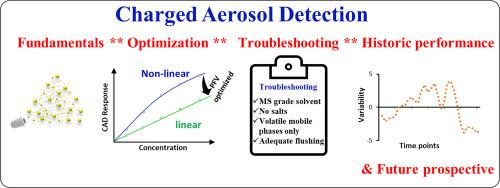A simplified tutorial on charged aerosol detection: Understanding the basics, optimization, and troubleshooting
IF 3.2
引用次数: 0
Abstract
The charged aerosol detector (CAD) measures the overall charge deposited on aerosolized particles to produce a signal proportional to the mass of analyte present, which applies to compounds with or without a chromophore. A significant benefit of CAD is the ability to quantitate a wide range of non-volatile compounds in absence of their authentic standards due to uniform response factor for such analytes. CAD is also a valuable tool to help detect and/or quantitate compounds with poor or no UV absorption. These can include salts, impurities, and a variety of other types of analytes.
In this tutorial, fundamental principles of CAD and its utilization, troubleshooting, and maintenance will be demonstrated to ensure proper CAD usage. Successful operation of CAD includes optimizing power function value (PFV) to allow for a broader dynamic range and improve uniformity of response. The use of an inverse gradient (admixed post-column) enables more accurate quantitation, when employing a gradient analysis method. Several troubleshooting strategies, including diagnosing inverse gradient pump organic solvent delivery and determining volume match/mismatch between the inverse gradient and system pumps, will be presented along with important aspects of operating a CAD. Lastly, ensuring reliable results involves monitoring the performance of CAD over time to understand whether it is working sufficiently or if maintenance is required.

带电气溶胶检测简明教程:了解基础知识、优化和故障排除
带电气溶胶检测器(CAD)测量沉积在气溶胶颗粒上的总电荷,产生与分析物质量成比例的信号,适用于带或不带发色团的化合物。CAD 的一个显著优点是,在没有真品标准的情况下,也能对多种非挥发性化合物进行定量,因为此类分析物的响应因子是一致的。CAD 还是帮助检测和/或定量紫外吸收差或无紫外吸收的化合物的重要工具。在本教程中,将演示 CAD 的基本原理及其使用、故障排除和维护,以确保正确使用 CAD。CAD 的成功操作包括优化功率函数值 (PFV),以获得更宽的动态范围并提高响应的一致性。在采用梯度分析方法时,使用反梯度(柱后混合)可实现更精确的定量。此外,还将介绍几种故障排除策略,包括诊断反梯度泵有机溶剂输送和确定反梯度泵与系统泵之间的体积匹配/不匹配,以及操作计算机辅助分析仪的重要方面。最后,为了确保可靠的结果,需要长期监控计算机辅助分析仪的性能,以了解其工作是否充分或是否需要维护。
本文章由计算机程序翻译,如有差异,请以英文原文为准。
求助全文
约1分钟内获得全文
求助全文
来源期刊

Journal of chromatography open
Analytical Chemistry
CiteScore
2.50
自引率
0.00%
发文量
0
审稿时长
50 days
 求助内容:
求助内容: 应助结果提醒方式:
应助结果提醒方式:


